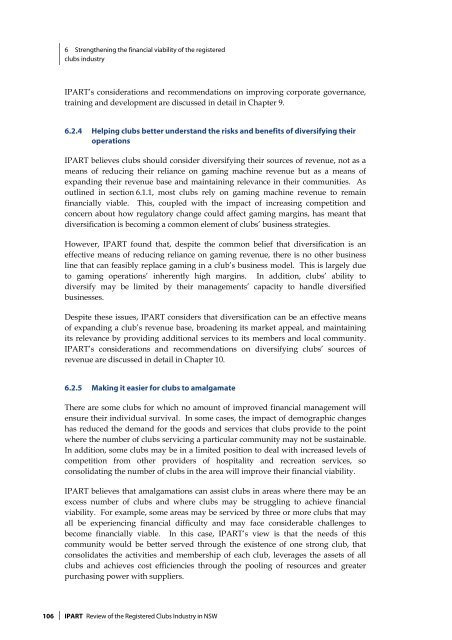Review of the Registered Clubs Industry in NSW - Clubs NSW
Review of the Registered Clubs Industry in NSW - Clubs NSW
Review of the Registered Clubs Industry in NSW - Clubs NSW
Create successful ePaper yourself
Turn your PDF publications into a flip-book with our unique Google optimized e-Paper software.
6 Streng<strong>the</strong>n<strong>in</strong>g <strong>the</strong> f<strong>in</strong>ancial viability <strong>of</strong> <strong>the</strong> registered<br />
clubs <strong>in</strong>dustry<br />
IPART’s considerations and recommendations on improv<strong>in</strong>g corporate governance,<br />
tra<strong>in</strong><strong>in</strong>g and development are discussed <strong>in</strong> detail <strong>in</strong> Chapter 9.<br />
6.2.4 Help<strong>in</strong>g clubs better understand <strong>the</strong> risks and benefits <strong>of</strong> diversify<strong>in</strong>g <strong>the</strong>ir<br />
operations<br />
IPART believes clubs should consider diversify<strong>in</strong>g <strong>the</strong>ir sources <strong>of</strong> revenue, not as a<br />
means <strong>of</strong> reduc<strong>in</strong>g <strong>the</strong>ir reliance on gam<strong>in</strong>g mach<strong>in</strong>e revenue but as a means <strong>of</strong><br />
expand<strong>in</strong>g <strong>the</strong>ir revenue base and ma<strong>in</strong>ta<strong>in</strong><strong>in</strong>g relevance <strong>in</strong> <strong>the</strong>ir communities. As<br />
outl<strong>in</strong>ed <strong>in</strong> section 6.1.1, most clubs rely on gam<strong>in</strong>g mach<strong>in</strong>e revenue to rema<strong>in</strong><br />
f<strong>in</strong>ancially viable. This, coupled with <strong>the</strong> impact <strong>of</strong> <strong>in</strong>creas<strong>in</strong>g competition and<br />
concern about how regulatory change could affect gam<strong>in</strong>g marg<strong>in</strong>s, has meant that<br />
diversification is becom<strong>in</strong>g a common element <strong>of</strong> clubs’ bus<strong>in</strong>ess strategies.<br />
However, IPART found that, despite <strong>the</strong> common belief that diversification is an<br />
effective means <strong>of</strong> reduc<strong>in</strong>g reliance on gam<strong>in</strong>g revenue, <strong>the</strong>re is no o<strong>the</strong>r bus<strong>in</strong>ess<br />
l<strong>in</strong>e that can feasibly replace gam<strong>in</strong>g <strong>in</strong> a club’s bus<strong>in</strong>ess model. This is largely due<br />
to gam<strong>in</strong>g operations’ <strong>in</strong>herently high marg<strong>in</strong>s. In addition, clubs’ ability to<br />
diversify may be limited by <strong>the</strong>ir managements’ capacity to handle diversified<br />
bus<strong>in</strong>esses.<br />
Despite <strong>the</strong>se issues, IPART considers that diversification can be an effective means<br />
<strong>of</strong> expand<strong>in</strong>g a club’s revenue base, broaden<strong>in</strong>g its market appeal, and ma<strong>in</strong>ta<strong>in</strong><strong>in</strong>g<br />
its relevance by provid<strong>in</strong>g additional services to its members and local community.<br />
IPART’s considerations and recommendations on diversify<strong>in</strong>g clubs’ sources <strong>of</strong><br />
revenue are discussed <strong>in</strong> detail <strong>in</strong> Chapter 10.<br />
6.2.5 Mak<strong>in</strong>g it easier for clubs to amalgamate<br />
There are some clubs for which no amount <strong>of</strong> improved f<strong>in</strong>ancial management will<br />
ensure <strong>the</strong>ir <strong>in</strong>dividual survival. In some cases, <strong>the</strong> impact <strong>of</strong> demographic changes<br />
has reduced <strong>the</strong> demand for <strong>the</strong> goods and services that clubs provide to <strong>the</strong> po<strong>in</strong>t<br />
where <strong>the</strong> number <strong>of</strong> clubs servic<strong>in</strong>g a particular community may not be susta<strong>in</strong>able.<br />
In addition, some clubs may be <strong>in</strong> a limited position to deal with <strong>in</strong>creased levels <strong>of</strong><br />
competition from o<strong>the</strong>r providers <strong>of</strong> hospitality and recreation services, so<br />
consolidat<strong>in</strong>g <strong>the</strong> number <strong>of</strong> clubs <strong>in</strong> <strong>the</strong> area will improve <strong>the</strong>ir f<strong>in</strong>ancial viability.<br />
IPART believes that amalgamations can assist clubs <strong>in</strong> areas where <strong>the</strong>re may be an<br />
excess number <strong>of</strong> clubs and where clubs may be struggl<strong>in</strong>g to achieve f<strong>in</strong>ancial<br />
viability. For example, some areas may be serviced by three or more clubs that may<br />
all be experienc<strong>in</strong>g f<strong>in</strong>ancial difficulty and may face considerable challenges to<br />
become f<strong>in</strong>ancially viable. In this case, IPART’s view is that <strong>the</strong> needs <strong>of</strong> this<br />
community would be better served through <strong>the</strong> existence <strong>of</strong> one strong club, that<br />
consolidates <strong>the</strong> activities and membership <strong>of</strong> each club, leverages <strong>the</strong> assets <strong>of</strong> all<br />
clubs and achieves cost efficiencies through <strong>the</strong> pool<strong>in</strong>g <strong>of</strong> resources and greater<br />
purchas<strong>in</strong>g power with suppliers.<br />
106 IPART <strong>Review</strong> <strong>of</strong> <strong>the</strong> <strong>Registered</strong> <strong>Clubs</strong> <strong>Industry</strong> <strong>in</strong> <strong>NSW</strong>
















